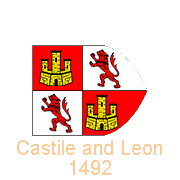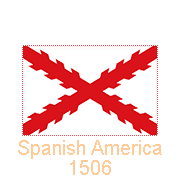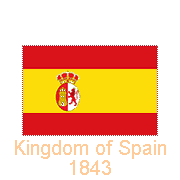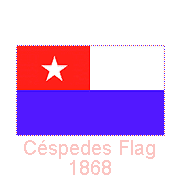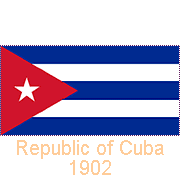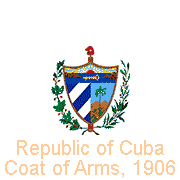Flags from Cuba
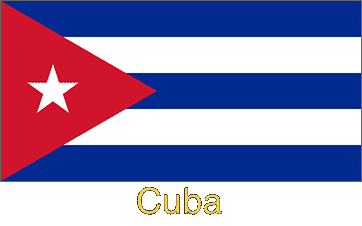
A Flag history of Cuba
Cuba’s modern history started on 27 November 1492 when Christopher Columbus landed near Baracoa on Cuba’s eastern coast. He sailed on behalf of the Spanish government. He carried the flag of Castile and Leon (Castilla y León), which therefore is reputedly the first to have flown in the Americas and Cuba. There was then no flag representing all of Spain, as regional flags were used. Since 1512 the kings of Castile and Leon were also kings of all the other lands making Spain. The “Cross of Burgundy” (representing the cross in which Saint Andrew was crucified, two crossed, roughly-pruned knotted branches) was first used in the 15th Century as an emblem by the Valois Dukes of Burgundy, a region in France and this symbol that fell to the House of Habsburg. The monarchs of Spain adopted it in the early 16th Century. From 1506 to 1701, Spain used it as a naval ensign and up to 1843 as the land battle flag. It served during the Spanish colonisation of the Americas as the flag of the Viceroyalties of the New World. It was under this flag Spain colonised Cuba.
you may then send it as a postcard if you wish.
When Charles III became King of Spain and the Spanish Indies in 1759, its warships flew a white flag with the sovereign’s arms. He was concerned it looked too similar to the flags of other nations that were also predominantly white; in war, it was difficult to determine if a ship was friend or foe. He ordered designs drawn up that would be distinct from a great distance. The flag chosen as war ensign in 1785 was a red-yellow-red triband, with the yellow band twice as wide as the red ones. It is the direct ancestor of the current Spanish flag: it became the National flag in 1843 and featured the coat of arms of Castile and Leon, surmounted with a crown. This flag also flew in Cuba until independence. On 10 October 1868, planter Carlos Manuel de Céspedes started a rebellion, the “Grito de Yara”. He used the “Flag of Yara” or “Flag of La Demajagua”, a simpler version of the flag that had been designed in 1848 or 1849 when many movements promoting Cuba’s independence from Spain were already active. Céspedes’ rebellion led to the Ten Year’s War which devastated the country; Céspedes was killed in 1874, and his home city of Bayamo was burned to the ground. When Cuba finally became independent in 1902, Céspedes Flag was officially designated the flag of Bayamo, the town of his birth. It is often displayed alongside the Cuban national flag at official ceremonies and events.
In 1848 or 1849, a Venezuelan general, Narciso López, designed a flag, and his wife embroidered it, “La Estrella Solitaria”, the Lone Star-banner. On 19 May 1850, he flew it in the city of Cárdenas, east of Havana. This flag was officially designated Cuba’s National Flag upon its independence on 20 May 1902. The three-light blue stripes (later changed to ocean blue) represent Cuba’s three sections: Western, Central, and Eastern. The two white stripes represent the purity and justice of the patriotic liberators’ motives, and the lone white star within the equilateral red triangle represents the unity of the Cuban people upon the blood spilled by their revolutionary heroes. The Cuban coat of arms, the official heraldic symbol of Cuba, was created by Miguel Teurbe Tolón and adopted on 24 April 1906. It consists of a shield in front of a fasces crowned by the Phrygian cap as a crown symbolising liberty, with a lone star standing for independence. On the shield, a key, a symbol of Cuba as the key to the Americas, is on a blue sea between two rocks symbolising Cuba’s geographical position between Florida and the Yucatán Peninsula. The bright rising sun in the background represents the rising of the new republic. On the left are the stripes of the flag of Cuba but turned diagonally. On the right is a typical Cuban landscape, the Royal Palm tree, a symbol of Cuba, with mountains in the background. All are supported by an oak branch on one side and a laurel wreath on the other.


